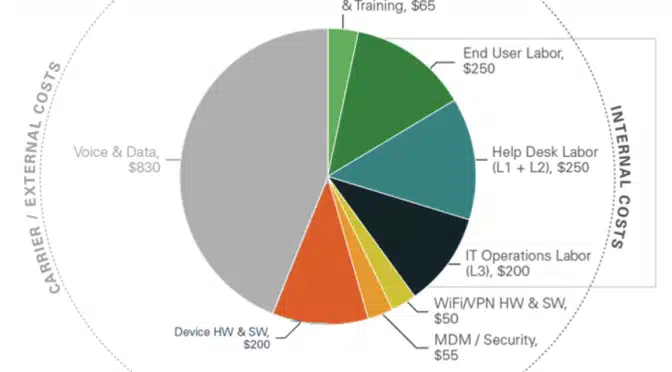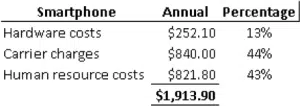
In 2012 Gartner, the world’s leading information technology research and advisory company, released a research paper called ‘Total Cost of Ownership of Mobile Devices: 2012 Update’. In the report, Gartner identified common usage patterns and support styles for different mobile devices, and estimated the total cost of ownership for each. The results were astounding to say the least. Ranging in TCO from between approximately USD 935 to USD 3,400 per annum, mobility is clearly not cheap. So why the great expense?
The true cost of today’s enterprise mobility goes well beyond the cost of devices and carrier charges. In the days of 2G mobility those were predominantly the costs we associated with mobility, but in today’s 3 & 4G landscape we have to deal with a far greater number of elements which contribute to the higher expense. Think about that for a minute – with a 2G phone we had Voice & SMS predominantly to play with. We made calls, we sent texts, and a few of us even attempted to use GPRS, either as a novelty, or as an interim solution to a business need that really was under-served by GPRS’ bandwidth limitations. In addition to device and carrier costs, you might have had an Administrator and an Accounts Payable resource spend a day per week managing the fleet or the bills. Contrast all this with today’s 3 & 4G environment of smartphones, tablets, and now hybrid devices. Not only do the devices cost 3-4 times what the 2G devices did, but they are clearly much more complex to manage and cost substantially more to support.
In the aforementioned Gartner report 43% of the annual calculated costs of Smartphones were human resource costs. Clearly that is much greater than you would imagine, but if you think about it carefully, it does make sense.

Figure 1 – Gartner TCO calculations – Total Cost of Ownership of Mobile Devices: 2012 Update’.
Smartphones and other internet enabled devices (tablets, dongles, phablets, etc.) are now really part of the IT landscape within an enterprise. In fact IT resources make up 32% of Gartner’s human resource figure above. What were once just mobile telephones are now mobile computers quite clearly, and as a result the high costs of IT management have crept in. Applications, processors, operating systems, storage, and browsers are all features of the Smartphone, and as enterprises grow their dependency on these devices, their investment in ‘mobility’ increases year by year.
So how do enterprises manage these growing costs of mobility? Let’s address each category above.
Hardware costs
Mobile computers (Smartphones) don’t come cheap if you want to buy a leading brand like Apple or Samsung. Having said that, does it make sense to pay for these brands for all staff? Enterprises with a good handle on mobility cost management do one of two things:
In the case of BYOD as a policy, users enjoy the experience that their favourite device brings them, but the cost is on them, not the enterprise. This has become more and more popular, hence the growth in MDM solutions from the likes of Airwatch, Mobile Iron, etc. In the case of differentiated hardware by employee (2), generally Executives are afforded the costly iPhones and Samsungs, whilst other employees receive lower cost devices. This is a sensible policy, and now with ‘Hardware as a Service’ options available to enterprises, costs can be dramatically reduced.
Carrier charges
Carriers have seemingly kept up with the rapid rise in demand for mobile data by offering generous data plans to enterprises, either at a per-device level or at a shared-plan level. Whilst attractive at first glance, the devil is in the detail as they say (see Steve Tot’s article called ‘Myth: Mobile Data Share Pools are virtually Unlimited’). In many of the detailed analysis reports, it is clear that one of the greatest areas for cost reduction is optimisation of the mobile data plan/s.
Many organisations view carrier charges as something best handled by rate negotiations or competition between carriers. However, is many organisations the “quick win” for containing carrier charges actually lies within: accurate data and analysis of usage patterns and volumes, and optimising plans and bundles to get the best value out of their existing arrangement. With the right cost management tools and services in place, organisation can easily and quickly reduce costs by optimising plans.
Human resource costs
The rapid move from a 2G world to a 3 & 4G world, as we noted previously, has driven up the human resource costs associated with enterprise mobility management. Of particular note is the growth in IT resource costs. Skills in mobile technologies, across applications, platforms, and security solutions are in great demand particularly, and it’s hard for companies to find skilled resources at a reasonable cost. Add to that the fact that the mobile technology environment changes rapidly every year, and it’s no wonder that enterprises struggle to manage these things well. Many large enterprises have now reached a stage where they are questioning the value of servicing these needs in-house. It’s not core business after all, and there are options available now to outsource your mobility requirements to lower costs and increase efficiencies. Commonly referred to as ‘integrated mobility management’, these programmes focus on providing a holistic, skilled managed service to companies at lower price points. They look to offer:
In summary, the true cost of enterprise mobility is bigger than most of us would imagine. Companies can take control of cost management though, through integrated management programmes from specialised partners, where savings far exceed the management fees.